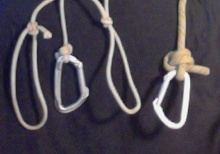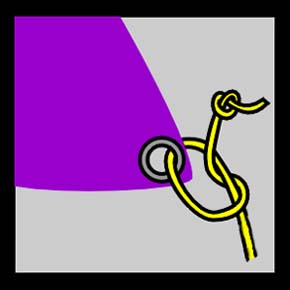|
Ashley's Stopper Knot
Ashley's stopper knot, also known as the oysterman's stopper, is a knot developed by Clifford W. Ashley around 1910. It makes a well-balanced trefoil-faced stopper at the end of the rope, giving greater resistance to pulling through an opening than other common stoppers. Essentially, the knot is a common overhand noose, but with the end of the rope passing through the noose eye, which closes upon it. It may be multiplied to form a larger knot with more than three bights appearing around the knot. It is the result of implementing a double wall knot in one strand. Ashley developed this knot in trying to duplicate a knot he saw on a boat in a local oyster fishing fleet. When he had a chance to observe the knot up close at a later time he realized it was just a badly water-swollen figure eight stopper knot. Tying # Form an overhand noose, or simply tie an overhand knot around the standing part as shown. # Tighten the overhand portion of the knot around the standing part. ... [...More Info...] [...Related Items...] OR: [Wikipedia] [Google] [Baidu] |
Knot
A knot is an intentional complication in cordage which may be practical or decorative, or both. Practical knots are classified by function, including hitches, bends, loop knots, and splices: a ''hitch'' fastens a rope to another object; a ''bend'' fastens two ends of a rope to each another; a ''loop knot'' is any knot creating a loop; and ''splice'' denotes any multi-strand knot, including bends and loops. A knot may also refer, in the strictest sense, to a stopper or knob at the end of a rope to keep that end from slipping through a grommet or eye. Knots have excited interest since ancient times for their practical uses, as well as their topological intricacy, studied in the area of mathematics known as knot theory. History Knots and knotting have been used and studied throughout history. For example, Chinese knotting is a decorative handicraft art that began as a form of Chinese folk art in the Tang and Song Dynasty (960–1279 AD) in China, later popularized in t ... [...More Info...] [...Related Items...] OR: [Wikipedia] [Google] [Baidu] |
Clifford Ashley
Clifford Warren Ashley (December 18, 1881 – September 18, 1947) was an American artist, author, sailor, and knot expert. Life Ashley was born in New Bedford, Massachusetts, son of Abiel Davis Ashley and Caroline Morse. He married Sarah Scudder Clark in 1932, with whom he had two daughters, one of whom is practicing painter Jane Ashley. He also adopted his wife's daughter from a previous marriage. He died in Westport Point, Massachusetts. Education and early work Taking an interest in art while still in high school, he went on to attend the Eric Pape Art School in Boston. In the summer of 1901 Ashley, along with friends N.C. Wyeth and Henry J. Peck, studied under George Noyes in Annisquam, Massachusetts. In the fall, he went on to become a student of Howard Pyle's school in Wilmington, Delaware. Pyle helped secure commissions for his students, and Ashley's early work included book frontispieces and illustrations for magazines such as ''The Delineator'', '' Leslies'', ... [...More Info...] [...Related Items...] OR: [Wikipedia] [Google] [Baidu] |
Stopper Knot
Stopper may refer to: * Bung, a plug used to stop the opening of a container ** Laboratory rubber stopper, a specific type of bung * Plug (sanitation), used to stop a drainage outlet * Defender (association football), in soccer (association football) * Milkor 37/38mm and 40mm Stopper, a gun * Alternative name for a whitewater hole, in whitewater kayaking * Glossary of contract bridge terms#stopper, Stopper, in the game of bridge * Glossary of baseball (S)#stopper, Stopper, in baseball, a key starting or relief pitcher * Slang for stopwatch, a handheld timepiece designed to measure the amount of time * Stopper knot, a type of a knot at the end of the rope * Stopper, a common name for some plant species in the genus ''Eugenia'' See also * * * Stop (other) {{disambig ... [...More Info...] [...Related Items...] OR: [Wikipedia] [Google] [Baidu] |
Overhand Noose
The double overhand noose is a very secure hitch knot. It might be used by cavers and canyoneers to bind a cow tail or a foot loop to a carabiner. Details File:Noeud double ganse-1.jpg, Make a bight File:Noeud double ganse-2.jpg, Turn around the standing end File:Noeud double ganse-3.jpg, the 2nd round rides the 1st File:Noeud double ganse nouage.jpg, Tie inside the two rounds File:Noeud double ganse-4.jpg File:Noeud double ganse-5.jpg, Tighten A heavily tightened double overhand noose will jam. The bound object has to be removed before untying. As the double overhand knot, it neither slips nor turns around. However, a third round turn might be useful with some highly lubricious spectra/nylon ropes. See also *List of hitch knots *List of knots This list of knots includes many alternative names for common knots and lashings. Knot names have evolved over time, and there are many conflicting or confusing naming issues. The overhand knot, for example, is also known as the ... [...More Info...] [...Related Items...] OR: [Wikipedia] [Google] [Baidu] |
Wall And Crown Knot
A wall and crown knot is a decorative kind of rope button. The original use of the knot was to put at the end of the ropes on either side of a gangway leading onto a ship as stoppers. A wall and crown knot consists of a wall knot and a crown knot with doubled strands..The strands of the wall knot go over, under twice, and over, while the strands of the crown knot go under, over twice, and under. In the wall and crown knot they are tied in opposite directions. This knot is often confused with a Turk's head knot, as both knots have a basket weave pattern. A Manrope knot(Double wall and crown, #847) is same knot as wall and crown knot but with little changes - crown strands doubled or tripled. in Verrill's book it is made from three-strand and crown strands doubled, in Ashley's book it is made from four-strand and crown strands tripled. File:Double wall and crown.PNG, Double wall and crown A crown knotAshley, Clifford W. (1944). ''The Ashley Book of Knots'', p.116. Doubled ... [...More Info...] [...Related Items...] OR: [Wikipedia] [Google] [Baidu] |
Oyster
Oyster is the common name for a number of different families of salt-water bivalve molluscs that live in marine or brackish habitats. In some species, the valves are highly calcified, and many are somewhat irregular in shape. Many, but not all oysters are in the superfamily Ostreoidea. Some types of oysters are commonly consumed (cooked or raw), and in some locales are regarded as a delicacy. Some types of pearl oysters are harvested for the pearl produced within the mantle. Windowpane oysters are harvested for their translucent shells, which are used to make various kinds of decorative objects. Etymology The word ''oyster'' comes from Old French , and first appeared in English during the 14th century. The French derived from the Latin , the feminine form of , which is the latinisation of the Ancient Greek () 'oyster'. Compare () 'bone'. Types True oysters True oysters are members of the family Ostreidae. This family includes the edible oysters, which mainly belong t ... [...More Info...] [...Related Items...] OR: [Wikipedia] [Google] [Baidu] |
Figure-eight Knot
The figure-eight knot or figure-of-eight knot is a type of stopper knot. It is very important in both sailing and rock climbing as a method of stopping ropes from running out of retaining devices. Like the overhand knot, which will jam under strain, often requiring the rope to be cut, the figure-eight will also jam, but is usually more easily undone than the overhand knot. The stevedore knot is the figure-eight knot with two half twists added before the end is finally stuck. Different types Figure-eight loop The figure-eight loop is used like an overhand loop knot. This type of knot can be used in prusik climbing when used in conjunction with a climbing harness, a climbing rope, and locking carabiner designed for climbing, to ascend or descend with minimal equipment and effort. Figure-eight bend The figure-eight bend knot is used to " splice" together two ropes, not necessarily of equal diameter. This knot is tied starting with a loose figure-eight knot on one rope ... [...More Info...] [...Related Items...] OR: [Wikipedia] [Google] [Baidu] |
The Ashley Book Of Knots
''The Ashley Book of Knots'' is an encyclopedia of knots written and illustrated by the American sailor and artist Clifford W. Ashley. First published in 1944, it was the culmination of over 11 years of work. The book contains 3,857 numbered entries (the final number, "3854", is added to by three "1/2" #s (794.5, 1034.5, & 2585.5) and, in later editions of the book, #1425a for Hunter's Bend; and one number has no entry) and approximately 7,000 illustrations. The entries include knot instructions, uses, and some histories, categorized by type or function. It remains one of the most important and comprehensive books on knots. Use as a reference Due to its scope and wide availability, ''The Ashley Book of Knots'' has become a significant reference work in the field of knotting. The numbers Ashley assigned to each knot can be used to unambiguously identify them. This helps to identify knots despite local colloquialisms or identification changes. Citations to Ashley numbers are usua ... [...More Info...] [...Related Items...] OR: [Wikipedia] [Google] [Baidu] |
Overhand Knot
The overhand knot is one of the most fundamental knots, and it forms the basis of many others, including the simple noose, overhand loop, angler's loop, reef knot, fisherman's knot, Half hitch, and water knot. The overhand knot is a stopper, especially when used alone, and hence it is very secure, to the point of jamming badly. It should be used if the knot is intended to be permanent. It is often used to prevent the end of a rope from unraveling. An overhand knot becomes a trefoil knot, a true knot in the mathematical sense, by joining the ends. It can also be adjusted, faired, or mis-tied as a half hitch Tying There are a number of ways to tie the Overhand knot. * Thumb method – create a loop and push the working end through the loop with your thumb. * Overhand method – create a bight, by twisting the hand over at the wrist and sticking your hand in the hole, pinch the working end with your fingers and pull through the loop. Heraldry In heraldry, the overhand knot ... [...More Info...] [...Related Items...] OR: [Wikipedia] [Google] [Baidu] |
Standing Part
A knot is an intentional complication in cordage which may be practical or decorative, or both. Practical knots are classified by function, including hitches, bends, loop knots, and splices: a ''hitch'' fastens a rope to another object; a ''bend'' fastens two ends of a rope to each another; a ''loop knot'' is any knot creating a loop; and ''splice'' denotes any multi-strand knot, including bends and loops. A knot may also refer, in the strictest sense, to a stopper or knob at the end of a rope to keep that end from slipping through a grommet or eye. Knots have excited interest since ancient times for their practical uses, as well as their topological intricacy, studied in the area of mathematics known as knot theory. History Knots and knotting have been used and studied throughout history. For example, Chinese knotting is a decorative handicraft art that began as a form of Chinese folk art in the Tang and Song Dynasty (960–1279 AD) in China, later popularized in t ... [...More Info...] [...Related Items...] OR: [Wikipedia] [Google] [Baidu] |





